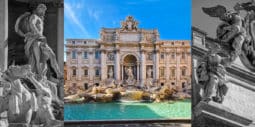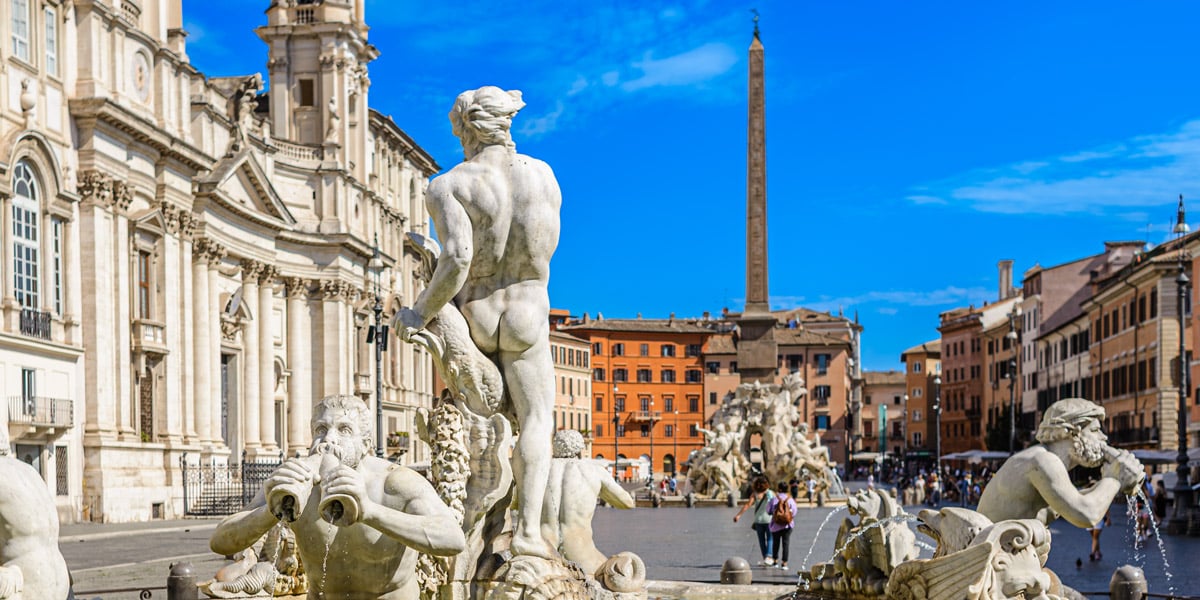
31038 views

Rome is a city of fountains and squares. There are about two thousand fountains from different centuries located in small or spacious piazzas with a rich history.
Contents
Here are 10 interesting and unusual facts about Roman fountains that only expert historians know. Memorize a few and surprise your friends during a self-guided tour of the Eternal City.
Here’s the list of the most beautiful Roman squares and fountains:
Piazza Navona is one of the most popular and refined squares in Rome. In ancient times, the athletic stadium was located on this spot of the metropolitan land, and Romans were watching the “agones” or the “games.”
That is why Piazza Navona was previously known as “Circus Agonalis” or “competition arena.” Today, the square is crowded with tourists who are willing to have a look at baroque fountains and ancient temples.
A great variety of souvenir shops placed all along the square help tourists cherish the memories of Rome and its beauties. Moreover, the famous Fountain of the Four Rivers is located in the piazza. If you want to live in the famous square of the city, read more about the best hotels in the Piazza Navona.
The Fountain of The Four Rivers (Fontana dei Quattro Fiumi) by Gian Lorenzo Bernini was inaugurated in 1651.
It was commissioned by Pope Innocent X and located in the Piazza Navona in Rome. Statues of the fountain symbolize four major rivers of that time: the Nile, the Ganges, the Danube, and the Rio de la Plata. Bernini’s masterpiece stands in front of the church of Sant’Agnese in Agone, a work of Borromini.
See also a Guide to Borromini’s Masterpieces in Rome.
The Fountain of Neptune is located at the north end of the Piazza Navona.
Previously, it was called “Fontana dei Calderari” because of the location near a small alley with different metal-based businesses.
Fontana del Moro (Moor Fountain) is located at the southern end of the Piazza Navona.
It embodies a Moor, or African (probably originally meant to be Neptune), standing in a conch shell, wrestling with a dolphin, and surrounded by four Tritons. In 2011, the fountain was damaged after a vandal attacked it with a hammer.
The Campo de’ Fiori is one of the main squares of the Eternal City.
It is popular because of its flower, fruit, and vegetable market during the daytime and for its restaurants and shisha bars at night. Many hotels, BnBs, and artisan workshops fill the area, one of the most famous parts of the Eternal City. Moreover, many gelaterias are located nearby the Campo dei Fiori.
The Spanish Steps are located on the top of Pincian Hill, right at the foot of Spanish Square (Italian: Piazza di Spagna).
The square attracts thousands of visitors to the Italian capital, and its steps serve as a primary source of inspiration to cinematographers and artists. Moreover, all famous brands such as Prada, Bulgari, and Dior are located in the square or within a short footwalk.
The Fountain of the Boat (Fontana della Barcaccia) is a Baroque-style fountain near the Spanish Steps.
Pietro Bernini built the fountain in 1623 as part of a prior Pope’s Urban VIII project to create a fountain in every major square in Rome. The fountain was finished between 1627 and 1629.
Piazza of Santa Maria in Trastevere is one of the most famous touristic areas for its excellent restaurants and international or speakeasy bars with low prices.
It is possible to reach the square within a footwalk from the historical center. Every evening many people come to eat Italian gelato or visit one of the restaurants located in the piazza. Moreover, there are shows by street artists every evening. The Famous Basilica of Santa Maria in Trastevere is in this square.
The Fountain in Piazza Santa Maria in Trastevere is located in the square in front of the church of Santa Maria in Trastevere. There is a belief that it is the oldest fountain in Rome, which dates back to the 8th century. The current fountain was made by Donato Bramante, with later additions by Bernini and Fontana.
Piazza del Campidoglio is located on the top of the Capitoline Hill in Rome and was designed by Michelangelo Buonarroti in 1538.
Roman Divinities were once praised there, while today, it is the headquarters of the Italian government. There are three main buildings: Palazzo Senatorio, Palazzo dei Conservatori, and Palazzo Nuovo.
Located in the Piazza del Campidoglio, the fountain was created by Michelangelo in about 1536, and it is also known as the “Senate Steps” or “Pallas Kidnapped.”
In the beginning, Fontana della Dea wasn’t intended as a fountain because the water didn’t reach the square until up to fifty years later. Rather, it is considered a superb ornament in Piazza del Campidoglio.
Piazza della Rotonda is one of the most famous squares in Rome because this is the site where the Pantheon is located. Moreover, a beautiful fountain is surrounded by different restaurants and gelaterias. The square is in the historic center and easily reachable from the most important Roman sites.
The fountain of the Rotonda Square (Fontana di Piazza della Rotonda) was constructed in 1575 and made from marble.
Its architect is Leonardo Sormani, while the design belongs to Giacomo della Porta.
Saint Peter Square is world-wide famous because of the Basilica di San Pietro, the largest church in the world and the symbol of the Vatican, located there. During the day time, there are too many tourists, and you should better visit the square during the night time or at dawn.
Piazza del Popolo is located between the Pincio district and the banks of the Tevere. There are churches, a fountain, monuments, and ancient and modern marble memoirs on the square. It was rebuilt by Valadier architect in 1834, who designed two half laps to the obelisk. Moreover, Piazza del Popolo is considered one of Rome’s largest squares and almost perfectly symmetrical.
Famous Villa Borghese located behind the square
Piazza della Madonna dei Monti is a small square popular among young locals and tourists on warm summer evenings. It would be a great choice to spend an evening there with a group of friends or come to one of the restaurants located on the square for Sunday brunch.
The fountain of the Catechumens (Fontana dei Catecumeni) was designed by Giacomo della Porta and executed by Battista Rusconi for Pope Sixtus V Peretti in 1588-89.
Additionally, its steps were built by Girolamo De Rossi in 1595. Moreover, the fountain was restored for Innocent XI Odescalchi in 1680 and then in 1880 and 1997, when the square became pedestrian.
Piazza Venezia, or Venice Square, is located in Rome’s center of four major roads.
These roads are the Via del Corso, Via del Plebiscito, Via di Teatre Marcello, and Via dei Fori Imperiali. Also, the square is famous for its chaotic traffic. Piazza Venezia was named after Cardinal Venezia, who ordered the construction of his place, Palazzo Venezia, in 1455.
Located in the beautiful Jewish Ghetto, Piazza Mattei is a quiet square with the famous Turtle Fountain (Fontana della Tartarughe). This square gives a sense of peace and tranquility at any time of the day.
The Turtle Fountain (Fontana della Tartarughe) is a fountain of the late Italian Renaissance.
It was built between 1580 and 1588 by Giacomo della Porta and Taddeo Landini. The bronze turtles around the upper basin were included during the fountain’s restoration in 1658-59 and attributed to Gian Lorenzo Bernini or Andrea Sacchi.
Piazza Barberini is a large square in the historic center of Rome, situated on Quirinal Hill. Initially, it was created in the 16th century, but buildings that surround the square went through several restorations over time. There are luxury hotels, bars, restaurants, and a cinema today.
Triton Fountain (Fontana del Tritone) is located at the center of Piazza Barberini and was sculpted by Bernini. The fountain is near the Palazzo Barberini entrance, which houses the Galleria Nazionale d’Arte Antica that Bernini helped design for the Urban family. A large muscular Triton is at the center of the fountain, depicted as a merman kneeling on the sum of four dolphin tailfins.
Piazza della Repubblica is located next to the Termini Railway station.
One of the main streets of Rome – Via Nazionale, starts from this square. Its former name was Piazza dell’Esedra because it originates in the large exedra of the Baths of Diocletian. The Basilica of Santa Maria degli Angeli e dei Martiri is based on a wing of the baths.
Fountain of the Naiads (Fontana delle Naiadi) is located in the center of the Piazza della Repubblica. The original Baths of Diocletian included the space now occupied by the fountain. Its main feature is in four Naiads (nymphs) located at the edge of the Naiad Fountain.
Piazza del Quirinale is located on the tallest of the seven hills of Rome, Quirinal Hill.
It offers impressive views of the city. Moreover, there is the obelisk located next to the statues on which Castor and Pollux, patrons of horse riders, are taming several horses. The Palazzo del Quirinale, located on the square, was designed as a summer residence for Pope Gregory XIII in 1573 and became the royal family residence after the unification of Italy.
The Fontana dei Dioscuri is set opposite the Palazzo del Quirinale. The new fountain was placed in 1818 in the square. It was commissioned by Pope Pius VII and was designed by Raffaele Stern.
The most famous and remarkable among hundreds of different fountains in Rome is considered to be the Trevi Fountain (Italian: Fontana di Trevi).
It has a perfect location and incredible beauty and attracts thousands of visitors to the Italian capital.
The Fontana dell’Acqua Paola is also known as Il Fontanone (“The big fountain”), located on the Janiculum (Gianicolo) Hill, right near the church of San Pietro in Montorio. It was built in 1612 and marked the end of the Acqua Paola aqueduct. The fountain was restored by Pope Paul V, so its name goes from him.
Moreover, it was the fist major fountain on the right bank of the Tiber River
The Fountain of Eagle (Fontana dell’Aquilone) located in the Vatican gardens, was commissioned by Pope Paul V and designed by Vasanzio.
The fountain was built near Casino di Pio IV, which is a small residence designed by Pirro Ligorio in 1561 for Pope Pius IV.
The Fountain of Frogs (Fontana delle Rane) is a baroque bowl fountain created in 1924 during the building of the Coppede neighborhood.
Eight frogs are on the top of the bowl, where water enters the fountain from their mouths and a central spray.
The Porter (Italian: Il Facchino) is one of the talking statues of the Eternal City. The fountain was initially located on the Via del Corso Street, near the Piazza Venezia. However, in 1874, it was moved to the via Lata. The statue was created in around 1580 and designed by Jacopo del Conte for the Corporazione degli Aquaroli.
The man’s face of the fountain is damaged, which is the consequence of paving stones thrown at it over the years
The Eternal City is magnificent and full of different squares and fountains with rich history and impressive decor. Tell us about your favorite square and fountain in Rome!
This website uses cookies. For more info read the cookies policy
Rome.us © 2025. Created with love by Roman experts and guides.